ORIGINAL: Fast Company
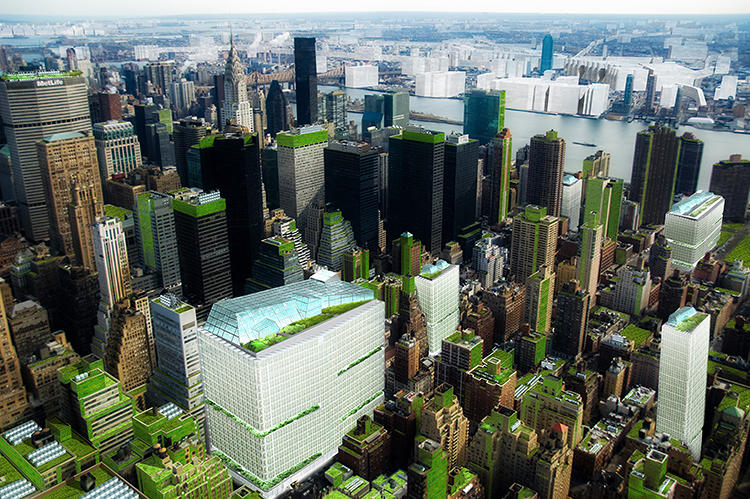 The Big Apple would be a lot greener if it needed to grow its own food.
The Big Apple would be a lot greener if it needed to grow its own food.

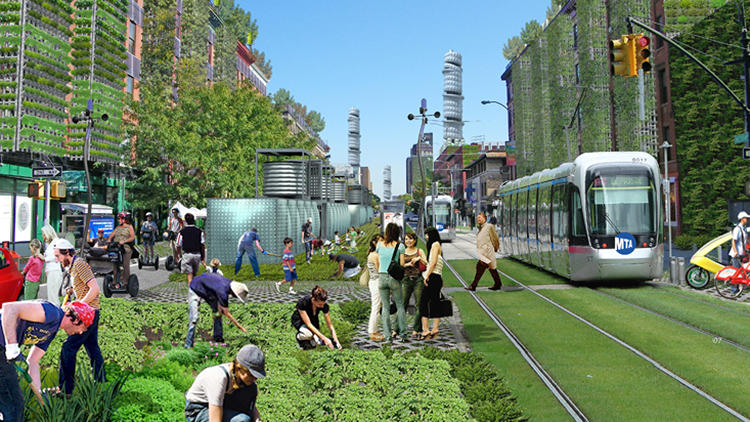
 “We discovered that with intense use of vertical agriculture and a change in diet, we could in fact physically provide the facilities to grow 2500 decent calories for every resident in New York."
“We discovered that with intense use of vertical agriculture and a change in diet, we could in fact physically provide the facilities to grow 2500 decent calories for every resident in New York."
 "But the energy estimates were so enormous we estimated that 25 nuclear power plants would be required.”
"But the energy estimates were so enormous we estimated that 25 nuclear power plants would be required.”
 Still, even if cities don’t necessarily become giant farms, the research can help point urban areas toward more sustainable choices.
Still, even if cities don’t necessarily become giant farms, the research can help point urban areas toward more sustainable choices.
 The researchers also looked at options for growing all food within 100 miles of the city, or growing everything within the state.
The researchers also looked at options for growing all food within 100 miles of the city, or growing everything within the state.
 “We looked at 100% autonomy-- what effort that would take, what forms, what living arrangements-- and we then look for some more reasonable response,” Sorkin says.
“We looked at 100% autonomy-- what effort that would take, what forms, what living arrangements-- and we then look for some more reasonable response,” Sorkin says.
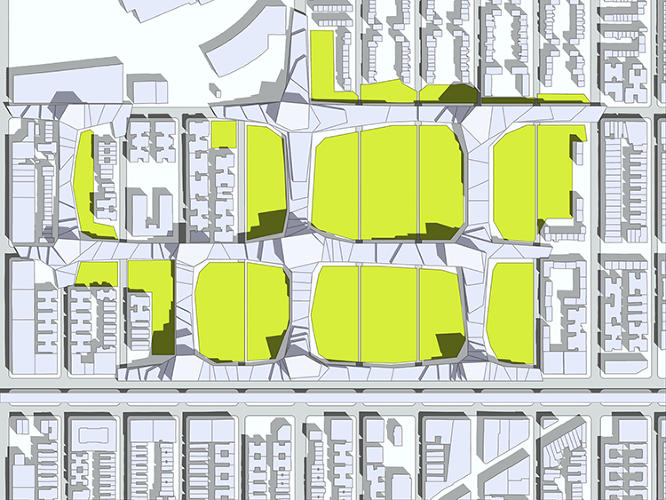 The research is part of a larger project called New York City (Steady) State, which will eventually detail how the city can be entirely self-sufficient, from energy to waste.
The research is part of a larger project called New York City (Steady) State, which will eventually detail how the city can be entirely self-sufficient, from energy to waste.

 It’s intended as a counterpoint to things like ecological footprints, which generically measure environmental impact.
It’s intended as a counterpoint to things like ecological footprints, which generically measure environmental impact.
 Here, the researchers are looking at specific and direct impacts in a confined area.
Here, the researchers are looking at specific and direct impacts in a confined area.
 "It’s a matter of taking responsibility for one’s effects on the planet," Sorkin says.
"It’s a matter of taking responsibility for one’s effects on the planet," Sorkin says.

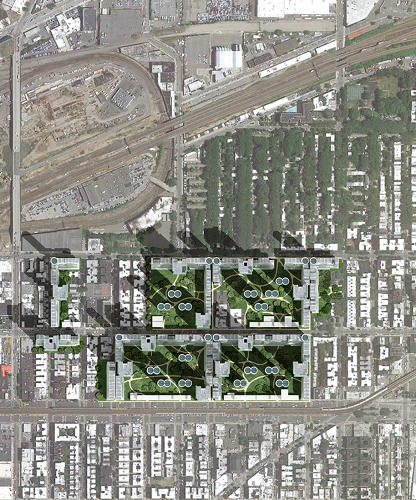 "New York is a good place to start because New Yorkers, as Americans, are enormous consumers."
"New York is a good place to start because New Yorkers, as Americans, are enormous consumers."
 The design includes everything from a skyscraper devoted to meat production (though Sorkin notes that it would be a lot easier, sustainability-wise, if everyone in the city became vegan), to rooftop "neighborhood food hubs" and streets that are turned into gardens.
The design includes everything from a skyscraper devoted to meat production (though Sorkin notes that it would be a lot easier, sustainability-wise, if everyone in the city became vegan), to rooftop "neighborhood food hubs" and streets that are turned into gardens.
 "We’re looking at all sorts of resources that we think are misused in New York, like streets," he explains.
"We’re looking at all sorts of resources that we think are misused in New York, like streets," he explains.

 "This is the largest area of space in the public realm. Imagine if we took half of the street out of the automobile realm and put it in the pedestrian realm: There could be farms, there could be daycare centers, there could be all sorts of public amenities."
"This is the largest area of space in the public realm. Imagine if we took half of the street out of the automobile realm and put it in the pedestrian realm: There could be farms, there could be daycare centers, there could be all sorts of public amenities."
 They found a few limits for food production; coffee, for example, is hard to grow in a vertical farm. Even in that case, they tried to find a local connection.
They found a few limits for food production; coffee, for example, is hard to grow in a vertical farm. Even in that case, they tried to find a local connection.
 After learning that Haiti grows enough coffee to supply half of New York's needs, they've proposed an agreement between the two locations.
After learning that Haiti grows enough coffee to supply half of New York's needs, they've proposed an agreement between the two locations.

 Haitians could be given education at schools like Columbia in exchange for selling New Yorkers coffee.
Haitians could be given education at schools like Columbia in exchange for selling New Yorkers coffee.
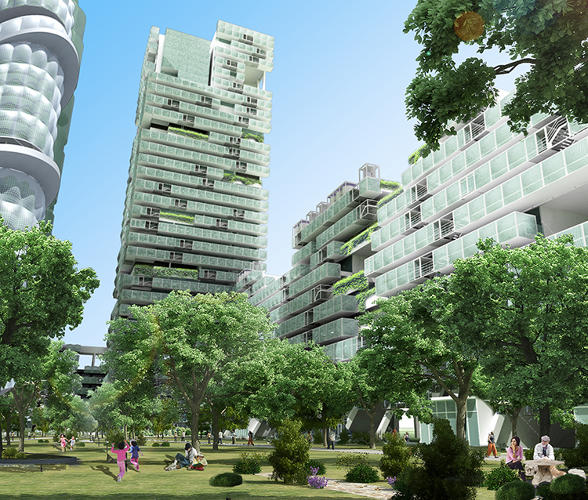 After Terreform completes research on other aspects of self-sufficiency, like energy, it will be putting together a resource for cities to use in planning.
After Terreform completes research on other aspects of self-sufficiency, like energy, it will be putting together a resource for cities to use in planning.
 "We're compiling an encyclopedia of the technologies and morphologies that could be used for cities around the world that are interested in moving in the direction of autonomy," Sorkin says.
"We're compiling an encyclopedia of the technologies and morphologies that could be used for cities around the world that are interested in moving in the direction of autonomy," Sorkin says.
 And they continue to push the boundaries of what self-sufficiency can mean.
And they continue to push the boundaries of what self-sufficiency can mean.
 "We're always asking a question about the nature of the membrane around the city," Sorkin says.
"We're always asking a question about the nature of the membrane around the city," Sorkin says.

"What would it be permeable to, what protections would have to be given to local production. It's an armature for speculation."







The Big Apple would be a lot greener if it needed to grow its own food.
The New York City (Steady) State is considering what it would mean if the city's 8 million residents were entirely self-sufficient, from the food they eat to the fuel they burn.
For the past six years, the urban research nonprofit Terreform has carefully considered exactly what New York City would look like if everything New Yorkers ate was grown inside city limits.
“At some level, it’s absurd,” says Michael Sorkin, who leads Terreform. “We discovered that with intense use of vertical agriculture and a change in diet, we could in fact physically provide the facilities to grow 2,500 decent calories for every resident in New York. But the energy estimates were so enormous we estimated that 25 nuclear power plants would be required.”
 Amsterdam Ave.
Amsterdam Ave.
Still, even if cities don’t necessarily become giant farms, the research can help point urban areas toward more sustainable choices. The researchers also looked at options for growing all food within 100 miles of the city, or growing everything within the state. “We looked at 100% autonomy--what effort that would take, what forms, what living arrangements--and we then look for some more reasonable response,” Sorkin says.
The research is part of a larger project called New York City (Steady) State, which will eventually detail how the city can be entirely self-sufficient, from energy to waste. It’s intended as a counterpoint to things like ecological footprints, which generically measure environmental impact.
Here, the researchers are looking at specific and direct impacts in a confined area.
"It’s a matter of taking responsibility for one’s effects on the planet," Sorkin says. "New York is a good place to start because New Yorkers, as Americans, are enormous consumers."
Why look at consumption on the level of the city? "Nation-states seem to be incompetent, and multi-nationals seem to be badly motivated," he says. "As an urbanist, I wanted to know what a city could actually accomplish if it decided to truly take responsibility."
 Sunnyside, Queens site
Sunnyside, Queens site
The design includes everything from a skyscraper devoted to meat production (though Sorkin notes that it would be a lot easier, sustainability-wise, if everyone in the city became vegan), to rooftop "neighborhood food hubs" and streets that are turned into gardens.
"We’re looking at all sorts of resources that we think are misused in New York, like streets," he explains. "This is the largest area of space in the public realm. Imagine if we took half of the street out of the automobile realm and put it in the pedestrian realm: There could be farms, there could be daycare centers, there could be all sorts of public amenities."
They found a few limits for food production; coffee, for example, is hard to grow in a vertical farm. Even in that case, they tried to find a local connection. After learning that Haiti grows enough coffee to supply half of New York's needs, they've proposed an agreement between the two locations: Haitians could be given education at schools like Columbia in exchange for selling New Yorkers coffee.
After Terreform completes research on other aspects of self-sufficiency, like energy, it will be putting together a resource for cities to use in planning. "We're compiling an encyclopedia of the technologies and morphologies that could be used for cities around the world that are interested in moving in the direction of autonomy," Sorkin says.
And they continue to push the boundaries of what self-sufficiency can mean. "We're always asking a question about the nature of the membrane around the city," Sorkin says. "What would it be permeable to, what protections would have to be given to local production. It's an armature for speculation."


For the past six years, the urban research nonprofit Terreform has carefully considered exactly what New York City would look like if everything New Yorkers ate was grown inside city limits.

“At some level, it’s absurd,” says Michael Sorkin, who leads Terreform.

























"What would it be permeable to, what protections would have to be given to local production. It's an armature for speculation."







The Big Apple would be a lot greener if it needed to grow its own food.
The New York City (Steady) State is considering what it would mean if the city's 8 million residents were entirely self-sufficient, from the food they eat to the fuel they burn.
For the past six years, the urban research nonprofit Terreform has carefully considered exactly what New York City would look like if everything New Yorkers ate was grown inside city limits.
“At some level, it’s absurd,” says Michael Sorkin, who leads Terreform. “We discovered that with intense use of vertical agriculture and a change in diet, we could in fact physically provide the facilities to grow 2,500 decent calories for every resident in New York. But the energy estimates were so enormous we estimated that 25 nuclear power plants would be required.”
 Amsterdam Ave.
Amsterdam Ave. Still, even if cities don’t necessarily become giant farms, the research can help point urban areas toward more sustainable choices. The researchers also looked at options for growing all food within 100 miles of the city, or growing everything within the state. “We looked at 100% autonomy--what effort that would take, what forms, what living arrangements--and we then look for some more reasonable response,” Sorkin says.
The research is part of a larger project called New York City (Steady) State, which will eventually detail how the city can be entirely self-sufficient, from energy to waste. It’s intended as a counterpoint to things like ecological footprints, which generically measure environmental impact.
Here, the researchers are looking at specific and direct impacts in a confined area.
"It’s a matter of taking responsibility for one’s effects on the planet," Sorkin says. "New York is a good place to start because New Yorkers, as Americans, are enormous consumers."
Why look at consumption on the level of the city? "Nation-states seem to be incompetent, and multi-nationals seem to be badly motivated," he says. "As an urbanist, I wanted to know what a city could actually accomplish if it decided to truly take responsibility."
 Sunnyside, Queens site
Sunnyside, Queens site The design includes everything from a skyscraper devoted to meat production (though Sorkin notes that it would be a lot easier, sustainability-wise, if everyone in the city became vegan), to rooftop "neighborhood food hubs" and streets that are turned into gardens.
"We’re looking at all sorts of resources that we think are misused in New York, like streets," he explains. "This is the largest area of space in the public realm. Imagine if we took half of the street out of the automobile realm and put it in the pedestrian realm: There could be farms, there could be daycare centers, there could be all sorts of public amenities."
They found a few limits for food production; coffee, for example, is hard to grow in a vertical farm. Even in that case, they tried to find a local connection. After learning that Haiti grows enough coffee to supply half of New York's needs, they've proposed an agreement between the two locations: Haitians could be given education at schools like Columbia in exchange for selling New Yorkers coffee.
After Terreform completes research on other aspects of self-sufficiency, like energy, it will be putting together a resource for cities to use in planning. "We're compiling an encyclopedia of the technologies and morphologies that could be used for cities around the world that are interested in moving in the direction of autonomy," Sorkin says.
And they continue to push the boundaries of what self-sufficiency can mean. "We're always asking a question about the nature of the membrane around the city," Sorkin says. "What would it be permeable to, what protections would have to be given to local production. It's an armature for speculation."
Comments
Post a Comment